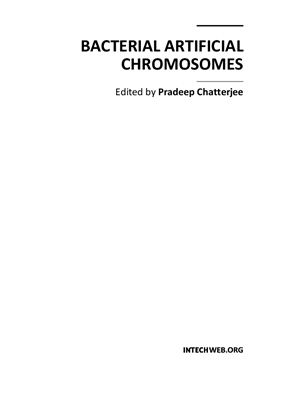InTech. 2011. 148 p.
This book focuses on the numerous applications of Bacterial Artificial Chromosomes (BACs) in a variety of studies. The topics reviewed range from using BAC libraries as resources for marsupial and monotreme gene mapping and comparative genomic studies, to using BACs as vehicles for maintaining the large infectious DNA genomes of viruses. The large size of the insert DNA in BACs and the ease of engineering mutations in that DNA within the bacterial host, allowed manipulating the BAC-viral DNA of Varicella-Zoster Virus. Other reviews include the maintenance and suitable expression of foreign genes from a Baculovirus genome, including protein complexes, from the BAC-viral DNA and generating vaccines from BAC-viral DNA genomes of Marek's disease virus. Production of multi-purpose BAC clones in the novel Bacillus subtilis host is described, along with chapters that illustrate the use of BAC transgenic animals to address important issues of gene regulation in vertebrates, such as functionally identifying novel cis-acting distal gene regulatory sequences.
Contents
Preface
BAC Libraries: Precious Resources for Marsupial and Monotreme Comparative Genomics
Recombineering of BAC DNA for the Generation of Transgenic Mice
Defining the Deletion Size in Williams-Beuren Syndrome by Fluorescent In Situ Hybridization with Bacterial Artificial Chromosomes
Functionalizing Bacterial Artificial Chromosomes with Transposons to Explore Gene Regulation
Functional Profiling of Varicella-Zoster Virus Genome by Use of a Luciferase Bacterial Artificial Chromosome System
Gene Functional Studies Using Bacterial Artificial Chromosome (BACs)
Bacterial Artificial Chromosome-Based Experimental Strategies in the Field of Developmental Neuroscience
Production of Multi-Purpose BAC Clones in the Novel Bacillus subtilis Based Host Systems
This book focuses on the numerous applications of Bacterial Artificial Chromosomes (BACs) in a variety of studies. The topics reviewed range from using BAC libraries as resources for marsupial and monotreme gene mapping and comparative genomic studies, to using BACs as vehicles for maintaining the large infectious DNA genomes of viruses. The large size of the insert DNA in BACs and the ease of engineering mutations in that DNA within the bacterial host, allowed manipulating the BAC-viral DNA of Varicella-Zoster Virus. Other reviews include the maintenance and suitable expression of foreign genes from a Baculovirus genome, including protein complexes, from the BAC-viral DNA and generating vaccines from BAC-viral DNA genomes of Marek's disease virus. Production of multi-purpose BAC clones in the novel Bacillus subtilis host is described, along with chapters that illustrate the use of BAC transgenic animals to address important issues of gene regulation in vertebrates, such as functionally identifying novel cis-acting distal gene regulatory sequences.
Contents
Preface
BAC Libraries: Precious Resources for Marsupial and Monotreme Comparative Genomics
Recombineering of BAC DNA for the Generation of Transgenic Mice
Defining the Deletion Size in Williams-Beuren Syndrome by Fluorescent In Situ Hybridization with Bacterial Artificial Chromosomes
Functionalizing Bacterial Artificial Chromosomes with Transposons to Explore Gene Regulation
Functional Profiling of Varicella-Zoster Virus Genome by Use of a Luciferase Bacterial Artificial Chromosome System
Gene Functional Studies Using Bacterial Artificial Chromosome (BACs)
Bacterial Artificial Chromosome-Based Experimental Strategies in the Field of Developmental Neuroscience
Production of Multi-Purpose BAC Clones in the Novel Bacillus subtilis Based Host Systems

